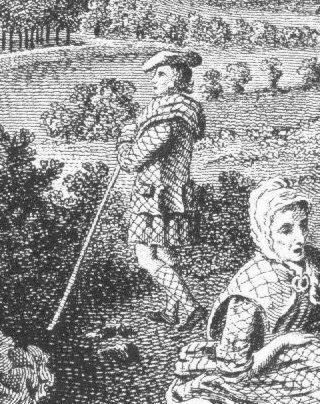|
-
20th October 06, 06:49 PM
#1
It's not a "two-part belted plaid." After the philabeg replaced the belted plaid as the common garment - mainly after the Proscription was lifted - Highlanders working or travelling in the countryside still utilized "plaids" as upper-body wraps and blankets (so did Lowlanders,actually). These were of a smaller dimension than the old full-sized plaid, and carried in the manner of an over-the-shoulder blanket roll. You can see this in this engraving circa 1770:

This is what you see being done in the "Rob Roy" film, perhaps too early historically. However, the costume advisor for the movie was Peter MacDonald - a very knowlegeable fellow regarding the history of tartan and Highland garb....
Brian
"They who can give up essential liberty to obtain a little temporary safety, deserve neither liberty nor safety." ~ Benjamin Franklin
-
-
20th October 06, 07:55 PM
#2
If you take your 4yard plaid for a feileadh-mhor and cut it length wise in the middle, you can simulate Liam Neison's garmet from "Rob Roy." By tucking the excess plaid (the shoulder piece), one can create the appearance of a feileadh-mhor. TRY IT! It will take some practice, but it can be done. This is what they probably did for the film. That's why some folks think he was wearing a feileadh-mhor and not a feileadh-beag.
Now, the actor playing Rob Roy's younger brother... I think they put him in a feileadh-mhor.
(The come on to Mary Scene): After Liam's swim/bath, I think he just puts on one of the halves of the plaid... Probably the half that was used as the upper portion. Interesting scene, b/c Highlander's typically only bathed once a year back then.
Interesting side note....
In 1998, when I worked at the STM with Matt... One day the tartan material from that film that Liam Neison wore was in the Museum.....
Matt came out of the office and says: "Hey Daniel!"
Me, "What?"
Matt, "touch this tartan"
I touch the tartan...
Matt, "Do you know what this is?"
Me, "No, but it looks familiar."
Matt, "It should, Liam Ne.....
you get the story.... sorry, I had to brag.
From what I've learned, the "Ancient Kilt style" used in Braveheart is not historical. Hollywood just could not make a film about Scotland's greatest hero and not put him in a kilt.. Hence the "Ancient Kilt." Think about it, the average person wouldn't recognize him as being Scottish without seeing him in a kilt.. So they probably theorized the width of the kilt from the width of a loom. If you watch your Braveheart DVD extra's, you'll see the "Irish Army" extra's fasten kilts to themselves that have draw strings (as my memmory serves me).. And the extra's kilts seem to be made from less yardage than Mel Gibson's kilt...
-
-
20th October 06, 10:33 PM
#3
Ancient and Great Kilt
The word plaid or plaide is just the Gaelic word for blanket. That etymology alone should allow one to understand the nature and origin of the garment. The Fèileadh Mhòr (literally "big or great wrap") was typically two 4-yard lengths of 27" fabric sewn selvedge-to-selvedge to make one 54" wide by 4-yard long piece of fabric. This was pleated (more like gathered, really) by hand and then worn belted.
The term Great Kilt is just a translation of the Gaelic as the word kilt itself is believed to come from the Middle English kilten = to tuck up.
The Fèileadh Beag ("little wrap" - anglicised as philabeg) was just the bottom half of the Fèileadh Mhòr with the top half worn on the shoulder still as a shawl or blanket. The closest descendant of that item today would probably be the drummer's or piper's plaid. The fly plaid, while still usable as a shawl if left unsewn, is a bit too small.
The Ancient Kilt you're referring to is probably the bizarre tartan "toga" styled garment they devised for the Braveheart film. I'm not really sure why they did this and didn't just use the Fèileadh Mhòr (even if it would have still been historically inaccurate).
As for Highlanders not bathing frequently that is simply not true. Highlanders, and by further extension Celts, traditionally prided themselves on cleanliness (unlike most Continental Europeans at the time - no offence!) If fact, they often removed much of their body hair to aid in this process - leaving only a handle-bar styled moustache.
I suspect this kind of thinking is a left-over bit of propanganda from the usual source. It makes one think of stuffy professors with lit pipes discussing "hairy Celts!" Harumph! Harumph! Similar thinking led to the 19th-century illustrations depicting the Irish peasantry as chimpanzee-like figures.
Sorry I got a bit side-tracked, I hope its illuminating!
Is mise le meas,
Seán Liosliath Ó hAirt
[B][COLOR="DarkGreen"]John Hart[/COLOR]
Owner/Kiltmaker - Keltoi
-
 Posting Permissions
Posting Permissions
- You may not post new threads
- You may not post replies
- You may not post attachments
- You may not edit your posts
-
Forum Rules
|
|
















Bookmarks